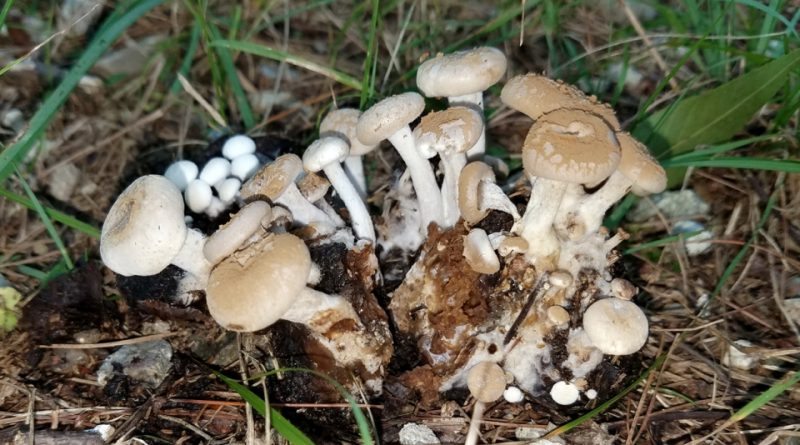Asterophora lycoperdoides
Asterophora lycoperdoides
Asterophora lycoperdoides (Asterophora lycoperdoides (Bull.) Ditm. Ex S.F. Gray) is a basidiomycete fungus belonging to the Lyophyllaceae family.
Systematics –
From a systematic point of view it belongs to:
Eukaryota Domain,
Kingdom Fungi,
Basidiomycota Division,
Basidiomycetes class,
Order Agaricales,
Lyophyllaceae family,
Genus Asterophora,
A. lycoperdoides species.
The terms are synonymous:
– Agaricus lycoperdoides Bull.;
– Agaricus lycoperdoides Sowerby;
– Artotrogus asterophora Fr.;
– Artotrogus lycoperdoides (Bull.) Kuntze;
– Asterophora agaricicola Corda;
– Asterophora agaricoides Fr.;
– Asterophora lycoperdoides (Bull. ex Merat) Gray;
– Asterophora lycoperdoides Fr.;
– Asterophora lycoperdoides var. trichoides (Fr.) Fr.;
– Asterophora nauseosa Weinm.;
– Asterophora trichioides Fr.;
– Asterotrichum ditmarii Bonord., 1851;
– Hypolyssus lycoperdoides (Bull.) Kuntze;
– Merulius lycoperdoides (Bull.) Gray;
– Merulius lycoperdoides (Bull.) Lam. & DC.;
– Nyctalis agaricoides (Fr.) Bon & Courtec.;
– Nyctalis agaricoides f. nauseosa (Weinm.) Bon;
– Nyctalis agaricoides subsp. nauseosa (Weinm.) Bon, 1995;
– Nyctalis asterophora Fr.;
– Nyctalis asterophora f. major J.E.Lange;
– Nyctalis lycoperdoides (Bull.) J.Schröt.;
– Nyctalis lycoperdoides (Bull.) Konrad & Maubl.;
– Nyctalis nauseosa (Weinm.) Fr..
Etymology –
The term Asterophora comes from the Greek ἀστήρ, -έροϛ astér, -éros stella, astro and from φορέω phoréo bring, have: endowed with a star-shaped chlamydospore.
The specific apithet lycoperdoides refers to the genus of mushrooms Lycoperdon (from the Greek λύκος lýcos lupo and from πέρδον perdon peto, loffa: wolf loffa, due to the particularity of the fungus to emit silent puffs of spores when ripe, if hit or crushed) and to the Greek term εἶδος eídos aspect, semblance: similar to a Lycoperdon.
Geographic Distribution and Habitat –
Asterophora lycoperdoides is a fungus whose habitat coincides with the presence of Russula (Nigricantinae) or Lactarius rotting fungi.
It grows mainly as a parasite on Russula of the “Nigrigantinae” group, and which also produces spores in the upper part of the cap, of agamic, asexual spores, ie chlamydospores.
In fact, more than a parasite, it would seem to be a saprophyte of the Russulae, as it seems that it invades them only after their complete vegetative cycle has ended, therefore it grows on already “dead” blackening Russula.
This mushroom therefore grows in habitats coinciding with Russule or Lactarius, in even very numerous groups, from summer to autumn, and is quite common.
Recognition –
The Asterophora lycoperdoides is recognized for having a hat with a diameter of 1-3 cm, first hemispherical, then convex, finally flattened, with a ± convoluted edge.
The cuticle is dry, whitish and flaky, then becomes covered with a hazelnut-colored powder (due to the presence of chlamydospores).
The hymenophore has sparse, absent or incomplete gills, reduced to thick and spaced sterile whitish grooves. Reproduction is entrusted to the chlamydospores that form on the surface of the hat.
The stem has dimensions of 2-3 x 0.3-0.8 cm, cylindrical in shape, curved, fibrillose, whitish or gray in color.
It has tender flesh, whitish cream in color, with an unpleasant, rancid smell and taste of flour.
Under the microscope we have: Pileipellis dissociated into chlamydospores. Star-shaped chlamydospores, with long pyramidal spines, 14-20 x 10-20 µm. Rare basidiospores, elliptic, smooth and hyaline 3-6 x 2-4 µm.
Cultivation –
Asterophora lycoperdoides is not a cultivated mushroom as it has no food value because it is not edible.
Customs and Traditions –
Asterophora lycoperdoides is a fungus with no food value that should not be confused with the rarer Asterophora parasitica, which shares the same growth habitat but has a fibrillar cap of whitish-silver gray color and smooth, ellipsoidal-spindle-shaped chlamydospores.
It should be emphasized that among the macrofungi it is one of the few to produce both chlamydospores on the cap and basidiospores on the lamellae. The chlamydospores form an ocher powder that covers the hat when ripe and are intended for an agamic and therefore non-sexual reproduction. Instead the spores on the gills under the hat produce the classic basidiospores intended for sexual reproduction.
Preparation Method –
Asterophora lycoperdoides is a fungus of no food interest as it is inedible. For this reason it should never be harvested in order not to disturb the delicate ecological role of this mushroom.
Guido Bissanti
Sources
– Wikipedia, the free encyclopedia.
– GBIF, the Global Biodiversity Information Facility.
– Useful Tropical Plants Database.
– Cetto B., 2008. Real mushrooms, Saturnia, Trento.
– Pignatti S., 1982. Flora of Italy, Edagricole, Bologna.
– Conti F., Abbate G., Alessandrini A., Blasi C. (ed.), 2005. An annotated checklist of the Italian vascular flora, Palombi Editore.
Photo source:
– https://inaturalist-open-data.s3.amazonaws.com/photos/110655440/original.jpg
– https://www.fungikingdom.net/we-invite-you-to-join-the/mycology-articles-by-pvma/asterophora-the-piggyback.html
Warning: Pharmaceutical applications and alimurgical uses are indicated for informational purposes only, they do not represent in any way a medical prescription; therefore no responsibility is taken for their use for curative, aesthetic or food purposes.


